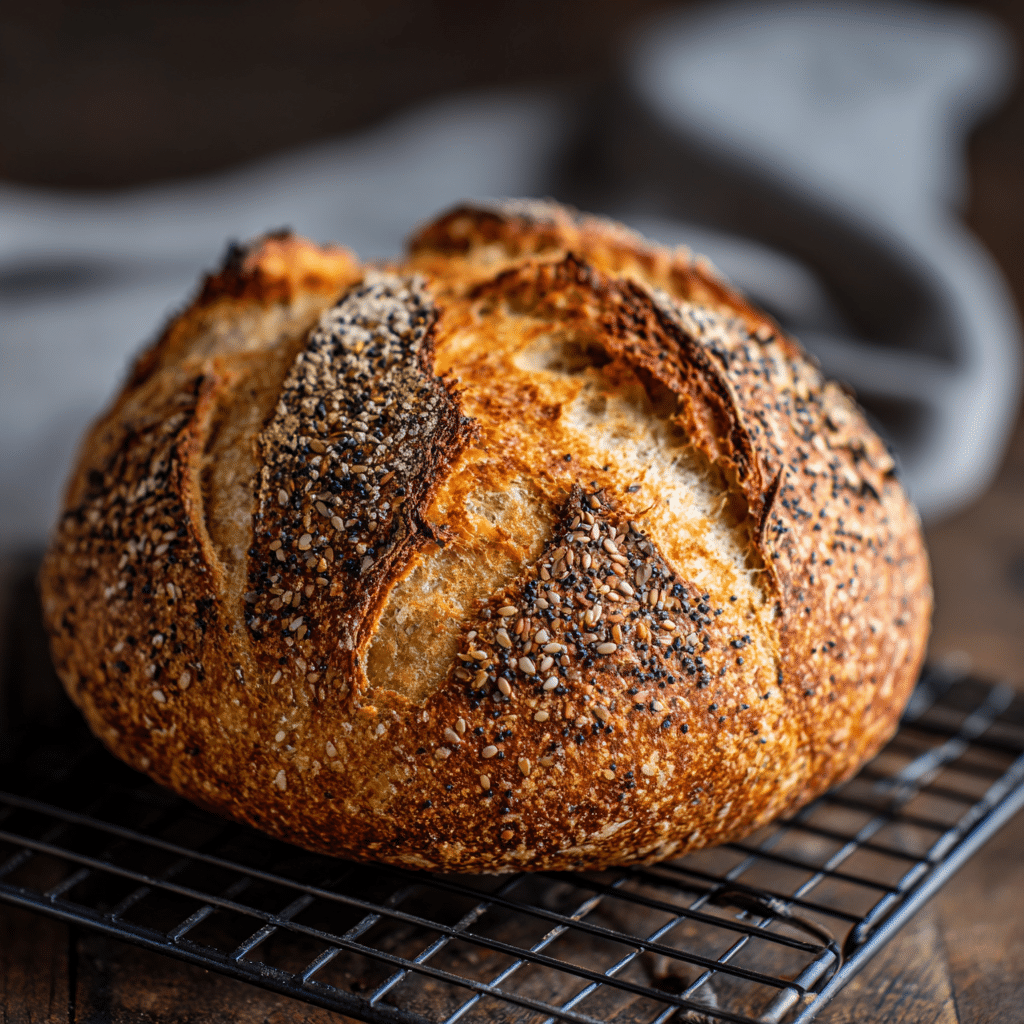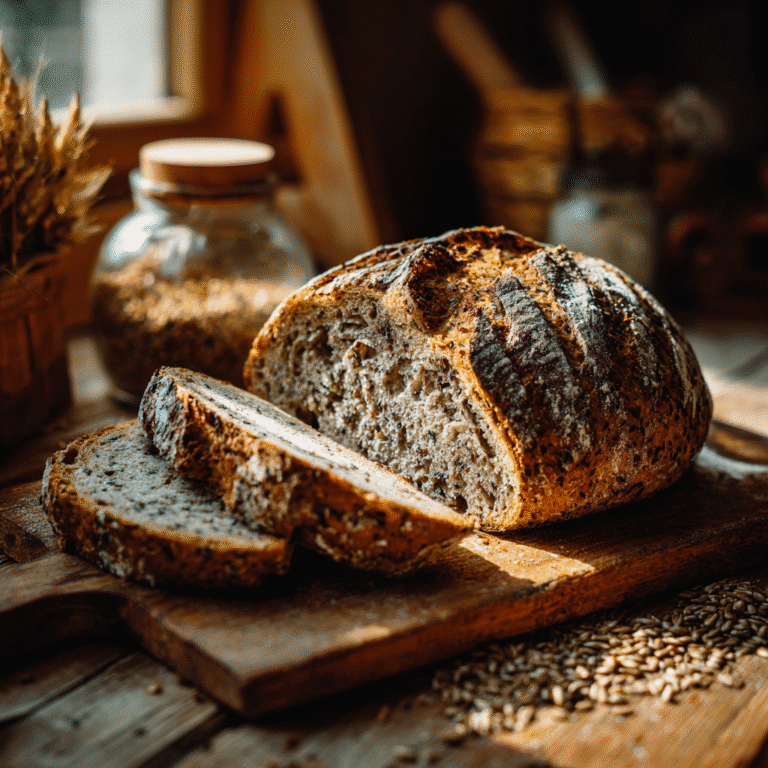Looking to bake a better loaf that’s not just crusty and flavorful but also gut-friendly? High-fiber sourdough is the answer. In this article, we’re diving into how to increase fiber in sourdough bread naturally and deliciously. We’ll explore fiber-rich flours, easy add-ins like seeds and grains, and how fermentation enhances digestion. Whether you’re focused on better bowel movements or seeking the healthiest sourdough bread possible, you’ll learn the practical steps and smart swaps that make your sourdough more nutritious without sacrificing taste. Let’s get your starter bubbling and your fiber levels soaring slice by slice.
Thank you for reading this post, don't forget to subscribe!Table of Contents
High-Fiber Sourdough: Boost Gut Health with Every Slice
There’s something sacred about pulling a fresh loaf of sourdough from the oven the crust crackling, the scent filling the kitchen, the anticipation building. For me, sourdough became more than just bread during the winter I first moved to Asheville. I was adjusting to a new routine, experimenting with garden veggies, and trying to find a healthier way to feed my family. That’s when I started making high-fiber sourdough.
This wasn’t your average loaf. I wanted something hearty, something that could actually do something for our bodies especially for gut health. My husband had been struggling with sluggish digestion, and I was on a mission. So I swapped out some white flour for whole grain, added a sprinkle of flaxseed here, some psyllium husk there, and watched our dough and our health transform.
The beauty of high-fiber sourdough is that you don’t need to be a nutritionist or a seasoned baker. You just need the right combination of flours, patience, and a little kitchen curiosity. In this guide, I’ll walk you through everything I’ve learned how to increase fiber content in sourdough bread, why it’s a game-changer for your digestive system, and which flours and add-ins can help you create the healthiest sourdough bread in your kitchen.
If you’ve ever wondered whether sourdough is good for bowel movements (spoiler: it is), or which bread is highest in fiber, you’re in the right place. Let’s get into it because your gut deserves better bread.
Print
High-Fiber Sourdough Loaves: Adding Seeds, Grains, and Nutrition
- Total Time: 14 hours (includes fermentation)
- Yield: 1 large loaf
Description
Crusty, flavorful, and gut-friendly, this high-fiber sourdough is packed with whole grains, seeds, and the benefits of natural fermentation for better digestion and overall health.
Ingredients
- 300g whole wheat flour
- 200g bread flour
- 100g rye flour
- 2 tbsp ground flaxseed
- 2 tbsp chia seeds
- 1 tbsp psyllium husk
- 2 tbsp wheat bran
- 400ml water (adjust as needed)
- 100g active sourdough starter
- 10g sea salt
Instructions
- In a large bowl, mix all flours with water and let rest for 30 minutes (autolyse).
- Add sourdough starter and mix until incorporated.
- Add salt, flaxseed, chia seeds, psyllium husk, and wheat bran. Mix until well combined.
- Perform stretch and folds every 30 minutes for the first 2 hours of bulk fermentation.
- Let dough ferment at room temperature for 6–8 hours, or until doubled in size.
- Shape the dough and place it in a well-floured banneton. Cover and refrigerate overnight for cold proofing.
- Preheat oven to 475°F (245°C) with a Dutch oven inside.
- Score the dough and bake covered for 20 minutes, then uncovered for another 25–30 minutes.
- Let the bread cool completely before slicing to retain moisture and crumb texture.
Notes
Pre-soak seeds for better hydration and texture. Start by replacing 25% of your flour with whole grain varieties if you’re new to high-fiber baking.
- Prep Time: 25 minutes
- Cook Time: 45 minutes
- Category: Bread
- Method: Baked
- Cuisine: Healthy Baking
How to Add Fiber to Your Sourdough Bread
Best Fiber-Boosting Ingredients for Sourdough
When it comes to boosting the fiber in your sourdough bread, the flour is your foundation. Swapping out all-purpose flour for whole grain flours like whole wheat, rye, or spelt instantly ups the fiber content. These flours retain the bran and germ, which is where most of the fiber lives.
You can also add oat bran, wheat bran, or even ground flaxseed directly into your dough. Just a couple of tablespoons per loaf can make a big difference in the final fiber count. Psyllium husk is another fiber-rich addition. It’s flavorless but helps retain moisture and improve texture especially useful if you’re going heavy on the grains.
Seeds are a high-fiber win, too. Try mixing in chia seeds, sunflower seeds, sesame, or pumpkin seeds. Not only do they add a nutty crunch, but they bring both soluble and insoluble fiber into the mix. Even soaked lentils or sprouted grains can be folded into the dough if you’re going for a rustic, multi-textured loaf.
Here’s a quick look at a few powerhouse fiber ingredients:
| Ingredient | Approx. Fiber per 2 Tbsp |
|---|---|
| Flaxseed (ground) | 4g |
| Chia Seeds | 5g |
| Wheat Bran | 6g |
| Psyllium Husk | 10g |
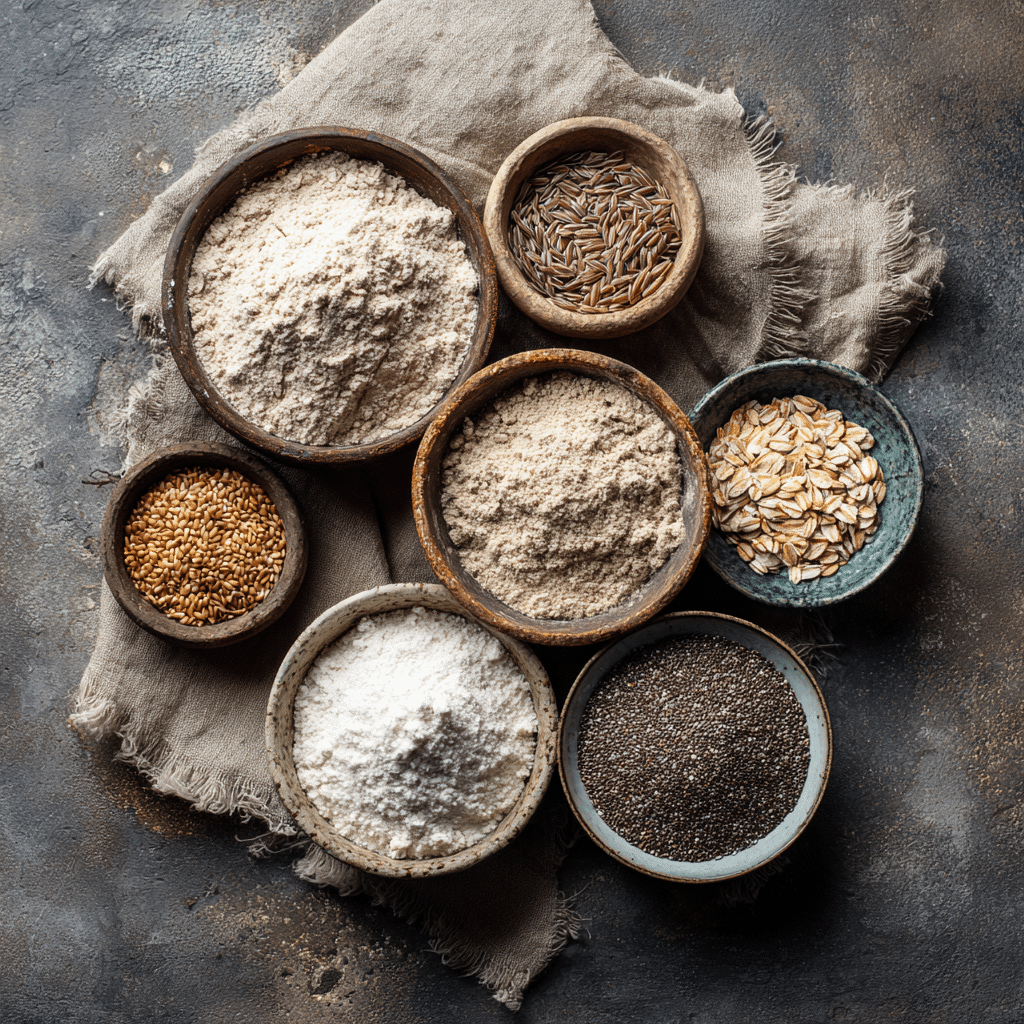
Smart Swaps That Preserve Flavor and Texture
Adding fiber to your sourdough doesn’t mean ending up with a brick. The trick is to maintain a delicate balance between hydration, fermentation, and structure. If you’re using whole wheat flour or bran, you’ll need to increase the water in your dough slightly since fiber absorbs more liquid.
A good starting ratio is replacing 25% of your white flour with a whole grain alternative. From there, you can go higher as you experiment. When adding seeds or bran, soak them beforehand so they don’t pull moisture from the dough as it proofs.
You can also incorporate a small amount of honey or molasses to balance out any bitterness from darker flours. Long, slow fermentation helps break down the tough parts of whole grains, resulting in a smoother flavor and softer crumb even in high-fiber loaves.
In the end, the goal is to create bread that’s both satisfying and beneficial to your digestive system without sacrificing the crusty chew we all love.
Choosing the Healthiest Sourdough Bread Options
Flour Types That Support Digestive Health
Not all sourdough is created equal especially when it comes to nutrition. If you’re trying to make or buy the healthiest sourdough bread, start with the flour. That one choice can dramatically influence how much fiber, minerals, and flavor end up in your slice.
Whole wheat flour is a classic go-to. It’s widely available, familiar to work with, and offers more than triple the fiber of white flour. But if you’re up for experimenting, ancient grains like spelt, einkorn, and emmer bring a deeper, nuttier taste while delivering naturally higher fiber and essential nutrients.
Rye flour is another standout. Not only does it pair beautifully with sourdough fermentation, but it also contains more soluble fiber, which is especially effective at supporting gut health and stabilizing blood sugar levels. A 100% rye sourdough loaf is denser, but mixing it 50/50 with whole wheat or white flour creates a balance of texture and health benefits.
For those with mild gluten sensitivity (not celiac), sourdough made from heritage grains like kamut or einkorn may be easier to digest due to the fermentation process and the lower gluten structure of these grains. Just remember that healthy doesn’t mean boring these flours bring complex, earthy flavors to the table.
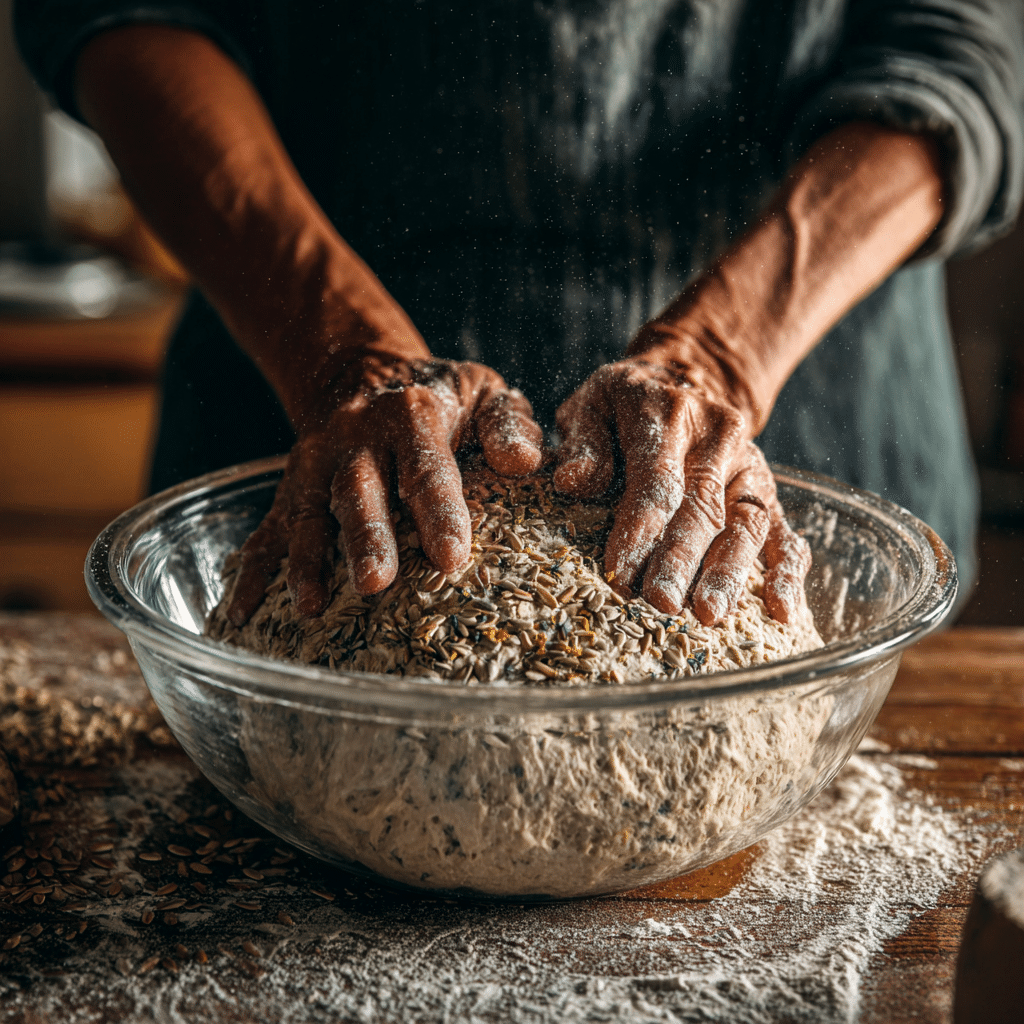
What Makes One Sourdough Healthier Than Another?
Beyond flour choice, several factors determine whether a sourdough loaf is truly healthy. One of the biggest is fermentation time. Long-fermented sourdough allows wild yeast and lactobacilli to break down complex starches and proteins, which can increase mineral absorption and make the bread easier to digest.
Another key factor is the starter’s quality and age. A mature, active starter is rich in beneficial microbes that help reduce phytic acid an anti-nutrient that can block mineral absorption. A vibrant starter also creates better leavening, allowing you to reduce added yeast or sugar entirely.
“If you’re avoiding gluten altogether, here’s our gluten-free sourdough bread recipe to try.”
Pay attention to hydration too. Higher-hydration loaves not only create a softer crumb, but also support better fermentation, especially when using high-fiber flours that absorb more water.
Lastly, avoid commercial sourdoughs with additives or enriched flours. Many supermarket loaves labeled “sourdough” are actually just white bread with added sour flavoring. Real sourdough should list flour, water, salt, and starter nothing more.
So if you want the healthiest sourdough bread, go for:
- Whole grain or ancient grain flours
- Long, slow fermentation
- No additives or commercial yeast
- A well-fed, active sourdough starter
When you combine all of these elements, your bread isn’t just good it becomes nourishing, wholesome, and deeply satisfying.
“Want to learn more? Here’s a full guide on whether sourdough bread is healthy for diabetics.”
Why Sourdough Helps with Bowel Movements
The Gut-Friendly Benefits of Sourdough Fermentation
If you’ve ever felt lighter after eating sourdough compared to other breads, there’s a reason for that. Sourdough’s natural fermentation process unlocks a whole range of digestive benefits and many of them directly improve bowel regularity.
During fermentation, wild yeast and lactic acid bacteria (like Lactobacillus) work together to pre-digest the starches and gluten in the flour. This process makes the nutrients in the bread more bioavailable and easier for your gut to process. One of the key outcomes is the production of prebiotics, which feed the good bacteria in your intestines.
Unlike probiotics (which are living organisms), prebiotics are indigestible plant fibers that serve as food for your gut flora. Sourdough made with whole grain or high-fiber flours creates a rich environment for these beneficial bacteria to thrive. And when your gut microbiome is healthy, your digestion including bowel movements runs far more smoothly.
“For readers with IBS or sensitive digestion, check out our Low FODMAP sourdough for sensitive guts recipe.”
Sourdough fermentation also reduces phytates, which can block the absorption of key minerals like magnesium and zinc. These minerals are essential for muscle function and nerve signaling, which includes the muscles in your digestive tract. In short, better absorption equals better motility.
High-Fiber vs. Regular Sourdough: Digestive Differences
While standard white sourdough can still be easier on the stomach than conventional bread, high-fiber sourdough takes it a step further. The added fiber from whole grains, seeds, and bran provides bulk to stool and stimulates the colon, helping to regulate bowel movements.
Insoluble fiber (like that from wheat bran) passes through your system mostly intact, acting like a broom to sweep your digestive tract. Soluble fiber (like that from flax or chia) forms a gel-like substance that softens stool and slows digestion just enough to improve nutrient absorption.
The fermentation process also increases short-chain fatty acids (SCFAs), like butyrate, which play a vital role in colon health and inflammation reduction. These SCFAs are produced when fiber is fermented in the gut, giving you a second wave of benefits from that morning slice.
If constipation or irregularity is an issue, high-fiber sourdough offers a gentle, natural solution. Unlike processed fiber supplements, this bread is whole, nourishing, and backed by the body’s own microbiome.
Bottom line: the combination of natural fermentation and high-fiber ingredients makes sourdough an ideal choice for supporting bowel regularity and overall digestive health.
Comparing High-Fiber Breads: Which Is Best?
Where Sourdough Ranks in the Fiber Game
If you’re on a mission to eat more fiber, it helps to know how high-fiber sourdough stacks up against other popular breads. While many people reach for multigrain or bran-heavy loaves, sourdough can actually compete and sometimes surpass other options, especially when made with whole grain flour and nutrient-rich add-ins.
Let’s break it down. Commercial white bread often contains only 1–2 grams of fiber per slice. Even basic sourdough made with refined flour hovers around 1.5–2 grams. But when you introduce whole wheat, rye, oat bran, flaxseed, or psyllium to a sourdough base, you can raise that number to 4–6 grams or more per slice, depending on your mix.
Compare that to some common breads:
- Whole wheat bread: ~2–3g fiber per slice
- Multigrain bread: ~3–4g (though many include refined flours)
- Oat bread: ~3–5g (depending on oat content)
- Sprouted grain bread: ~4–5g
- High-fiber sourdough: 4–6g+ (when properly made)
Sourdough also has one unique advantage: fermentation. While most other breads offer fiber through ingredients alone, sourdough enhances digestion through its microbial breakdown of starches and gluten. That makes it a strong contender not only in fiber content but in how your body actually uses it.
“High-fiber bread can be exciting too—just look at our blueberry lemon sourdough bread for a flavorful example.”
Store-Bought vs. Homemade: Nutritional Showdown
It’s no surprise that homemade bread generally wins when it comes to control over ingredients but with high-fiber sourdough, that control is everything. Store-bought loaves often contain preservatives, dough conditioners, and sugars that undermine the natural benefits of fiber. Even “sourdough” labels on supermarket shelves can be misleading many are made with commercial yeast and just a touch of vinegar for tang.
Making high-fiber sourdough at home lets you choose every single element: the flours, the mix-ins, the hydration level, and the fermentation time. You can soak seeds for better digestion, increase hydration for softness, and extend the proof for greater nutritional value.
Plus, you’ll never find a loaf at the store with a full fermentation schedule, psyllium husk, and chia seeds blended into a whole rye base unless you make it yourself.
If convenience is non-negotiable, look for bakery-fresh sourdough made with whole grains and minimal ingredients. Avoid anything with added sugar, artificial souring agents, or fiber added as a supplement. Natural fiber from real food always wins.
In short, the best high-fiber bread isn’t just about grams on the label it’s about how well it supports your gut, your taste preferences, and your lifestyle. And homemade high-fiber sourdough delivers on all fronts.
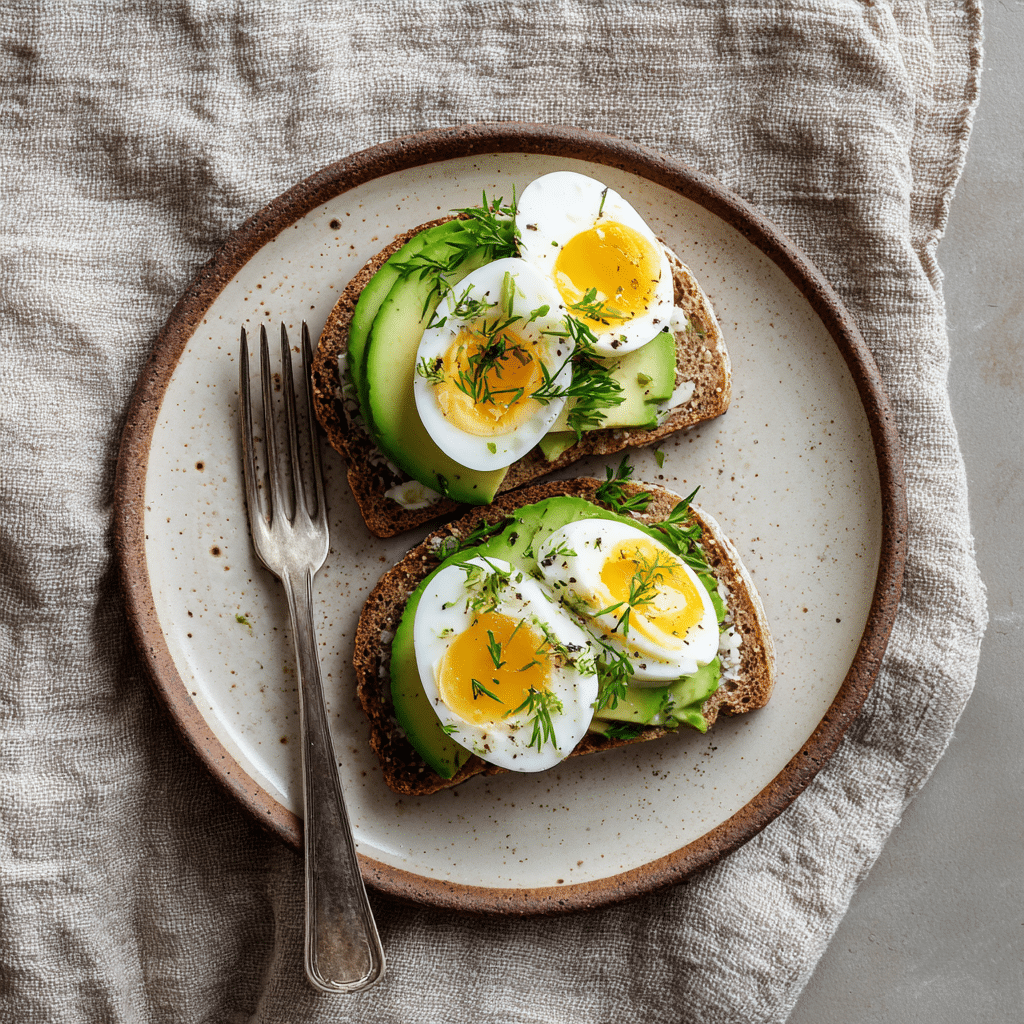
Tips to Bake the Ultimate High-Fiber Sourdough
Recipe Techniques That Boost Nutrition
Making high-fiber sourdough at home isn’t just about tossing seeds into dough. It’s about understanding how each step from mixing to fermentation affects both fiber content and digestibility. The good news? A few simple techniques can dramatically improve your results.
Start with whole grain flours. Replace at least 25–50% of your white flour with whole wheat, spelt, or rye. Each of these grains brings a rich, hearty texture and natural fiber. If you’re new to baking with whole grains, blend them slowly into your go-to recipe to maintain structure and hydration.
Add-ins like flaxseed, chia, oat bran, and psyllium husk work best when pre-soaked. This step prevents them from pulling moisture from your dough and helps improve the crumb. A good rule of thumb is to soak 1 tablespoon of seed mix in 2 tablespoons of water for about 20 minutes before adding it to your dough during bulk fermentation.
Use a higher hydration dough (75% or more) when working with fiber-rich ingredients. This keeps the loaf from drying out and allows for better oven spring.
Long fermentation at least 12 to 18 hours makes a big difference. It breaks down phytic acid in whole grains and increases mineral absorption, especially magnesium and iron. Letting your dough rise slowly also enhances the complex flavor you want in sourdough.
“For a hearty variation, check out our sourdough discard soda bread recipe.”
Avoiding Common Mistakes When Adding Fiber
Adding too much fiber too quickly can lead to dense, heavy loaves. That’s one of the biggest mistakes beginners make. Instead, gradually work up your percentages of bran or whole grain flours. Start with a 25% swap and test your hydration and structure before going higher.
Don’t forget the salt. Whole grain and high-fiber doughs need strong seasoning to bring out their nutty, earthy flavors. Use unrefined sea salt if you can it adds minerals and complexity.
Watch your fermentation time closely. Fiber-rich doughs can overproof more quickly because the added ingredients break down faster during the rise. If your dough feels very airy or bubbles burst easily, it’s time to shape and chill.
Another common issue? Underbaked loaves. High-fiber sourdough retains more moisture, so it often needs a longer bake. Use a thermometer to check the internal temp it should hit around 205°F (96°C) to be fully baked through.
With the right techniques and a bit of patience, you can turn any sourdough into a hearty, fiber-packed loaf that’s not only healthy but absolutely delicious.
Frequently Asked Questions
How do you add fiber to your sourdough bread?
You can increase fiber in sourdough by replacing white flour with whole grain options like whole wheat, rye, or spelt. You can also mix in fiber-rich ingredients such as flaxseed, chia seeds, wheat bran, oat bran, and psyllium husk. Soaking seeds before adding them to dough improves hydration and prevents a dry texture.
What is the healthiest sourdough bread?
The healthiest sourdough bread is made from whole grain flour and fermented for an extended period (12–18 hours). Look for or bake loaves with minimal ingredients just flour, water, salt, and a natural starter. Sourdough with added seeds, bran, or sprouted grains offers additional fiber and nutrients.
Is sourdough good for bowel movements?
Yes, sourdough can support better bowel movements. The natural fermentation process produces prebiotics and short-chain fatty acids that feed beneficial gut bacteria. When made with high-fiber ingredients, sourdough promotes regular digestion and can help relieve constipation naturally.
What bread has the highest fiber?
Breads made with 100% whole wheat, bran, or sprouted grains typically contain the highest fiber. However, high-fiber sourdough made from whole grains and seeds often surpasses store-bought multigrain breads due to its improved digestibility and fermentation-enhanced nutrients.
“Looking to reduce waste while staying gut-friendly? Try our sourdough discard English muffins.”
Why High-Fiber Sourdough Deserves a Spot at Your Table
High-fiber sourdough isn’t just a healthier alternative it’s a flavorful, gut-friendly loaf that supports real wellness without sacrificing comfort or tradition. With the right flour, a few smart add-ins, and a bit of patience, you can create bread that not only tastes amazing but also fuels your body in all the right ways.
From easing digestion to improving bowel movements, sourdough’s natural fermentation pairs beautifully with fiber-rich ingredients to create a loaf that works with your body not against it. Unlike ultra-processed breads, this one stays true to the basics: flour, water, salt, and time.
You don’t need fancy tools or professional training to bake better bread. All you need is curiosity, good ingredients, and the willingness to keep learning. That’s how I got here, and that’s why I’ll keep baking high-fiber sourdough for my family and now, hopefully, you will too.
So preheat that oven. Feed your starter. And go make something that’s both delicious and nourishing one loaf at a time.
Follow us on Facebook for fresh new recipes, cooking tips, and food inspiration every week!
